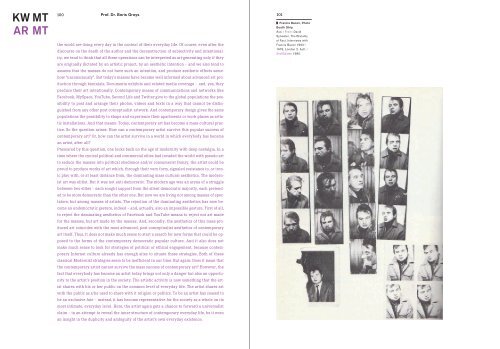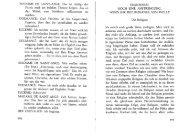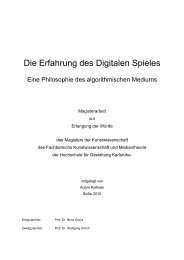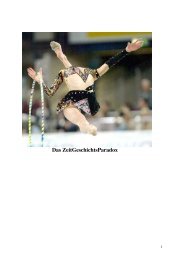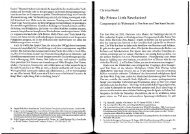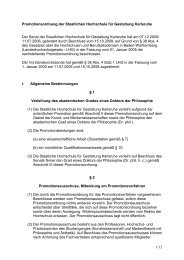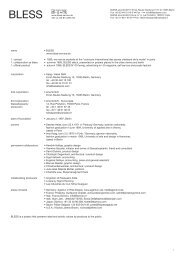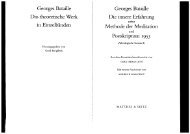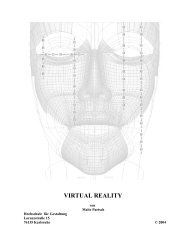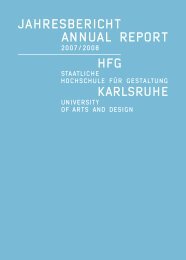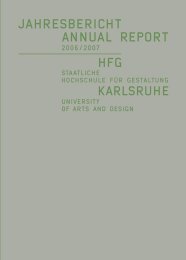HfG Karlsruhe Jahresbericht Staatliche Hochschule für Gestaltung ...
HfG Karlsruhe Jahresbericht Staatliche Hochschule für Gestaltung ...
HfG Karlsruhe Jahresbericht Staatliche Hochschule für Gestaltung ...
Sie wollen auch ein ePaper? Erhöhen Sie die Reichweite Ihrer Titel.
YUMPU macht aus Druck-PDFs automatisch weboptimierte ePaper, die Google liebt.
KW MT<br />
AR MT<br />
100 Prof. Dr. Boris Groys<br />
101<br />
the world are doing every day in the context of their everyday life. Of course, even after the<br />
discourse on the death of the author and the deconstruction of subjectivity and intentionality,<br />
we tend to think that all these operations can be interpreted as art-generating only if they<br />
are originally dictated by an artistic project, by an aesthetic intention – and we also tend to<br />
assume that the masses do not have such an intention, and produce aesthetic effects somehow<br />
“unconsciously”. But today’s masses have become well informed about advanced art production<br />
through biennials, Documenta exhibits and related media coverage – and, yes, they<br />
produce their art intentionally. Contemporary means of communications and networks like<br />
Facebook, MySpace, YouTube, Second Life and Twitter give to the global populations the possibility<br />
to post and arrange their photos, videos and texts in a way that cannot be distinguished<br />
from any other post-conceptualist artwork. And contemporary design gives the same<br />
populations the possibility to shape and experience their apartments or work places as artistic<br />
installations. And that means: Today, contemporary art has become a mass cultural practice.<br />
So the question arises: How can a contemporary artist survive this popular success of<br />
contemporary art? Or, how can the artist survive in a world in which everybody has become<br />
an artist, after all?<br />
Pressured by this question, one looks back on the age of modernity with deep nostalgia. In a<br />
time where the cynical political and commercial elites had invaded the world with pseudo-art<br />
to seduce the masses into political obedience and/or consumerist frenzy, the artist could be<br />
proud to produce works of art which, through their very form, signaled resistance to, or ironic<br />
play with, or at least distance from, the dominating mass cultural aesthetics. The modernist<br />
art was elitist. But it was not anti-democratic. The modern age was an arena of a struggle<br />
between two elites – each sought support from the silent democratic majority, each pretended<br />
to be more democratic than the other one. But now we are living not among masses of spectators,<br />
but among masses of artists. The rejection of the dominating aesthetics has now become<br />
an undemocratic gesture, indeed – and, actually, also an impossible gesture. First of all,<br />
to reject the dominating aesthetics of Facebook and YouTube means to reject not art made<br />
for the masses, but art made by the masses. And, secondly, the aesthetics of this mass-produced<br />
art coincides with the most advanced, post-conceptualist aesthetics of contemporary<br />
art itself. Thus, it does not make much sense to start a search for new forms that could be opposed<br />
to the forms of the contemporary democratic popular culture. And it also does not<br />
make much sense to look for strategies of political or ethical engagement, because contemporary<br />
Internet culture already has enough sites to situate these strategies. Both of these<br />
classical Modernist strategies seem to be inefficient in our time. But again: Does it mean that<br />
the contemporary artist cannot survive the mass success of contemporary art? However, the<br />
fact that everybody has become an artist today brings not only a danger but also an opportunity<br />
to the artist’s position in the society. The artistic activity is now something that the artist<br />
shares with his or her public on the common level of everyday life. The artist shares art<br />
with the public as s/he used to share with it religion or politics. To be an artist has ceased to<br />
be an exclusive fate – instead, it has become representative for the society as a whole on its<br />
most intimate, everyday level. Here, the artist again gets a chance to forward a universalist<br />
claim – in an attempt to reveal the inner structure of contemporary everyday life, be it even<br />
an insight in the duplicity and ambiguity of the artist’s own everyday existence.<br />
█ Francis Bacon, Photo<br />
Booth Strip<br />
Aus: / From: David<br />
Sylvester. The Brutality<br />
of Fact. Interviews with<br />
Francis Bacon 1962–<br />
1979, London 2. Aufl. /<br />
2nd Edition 1980.


